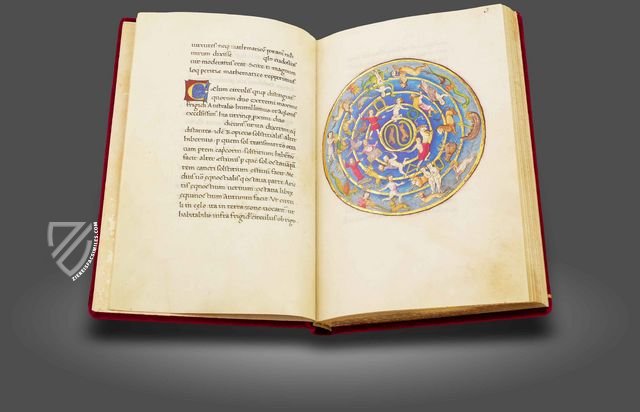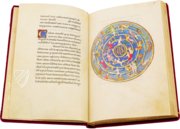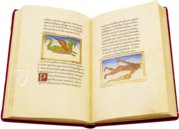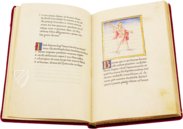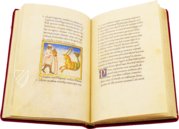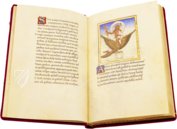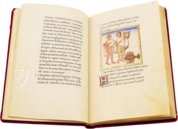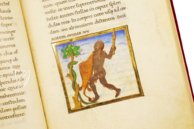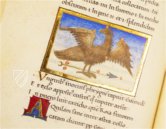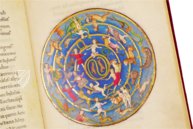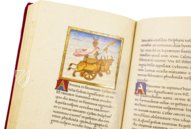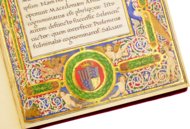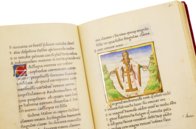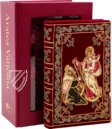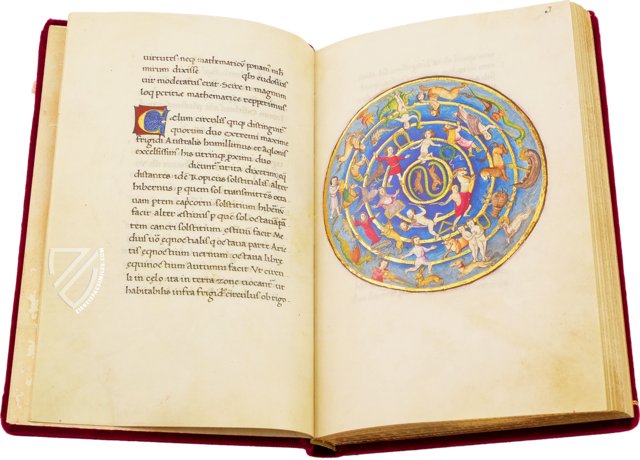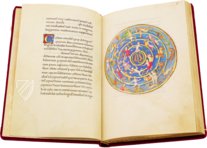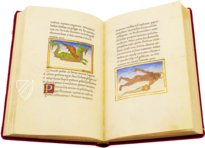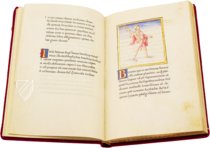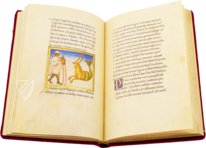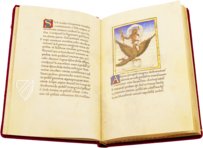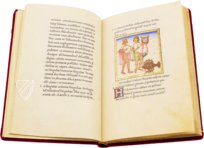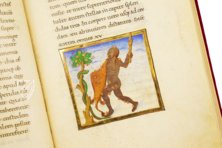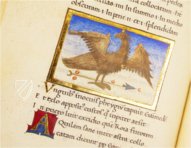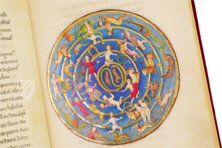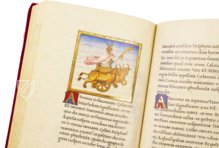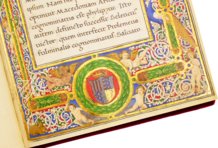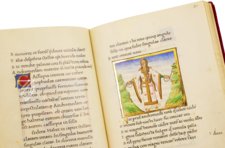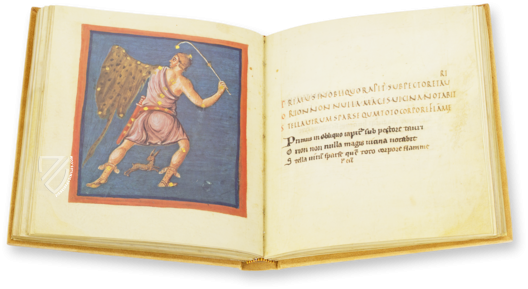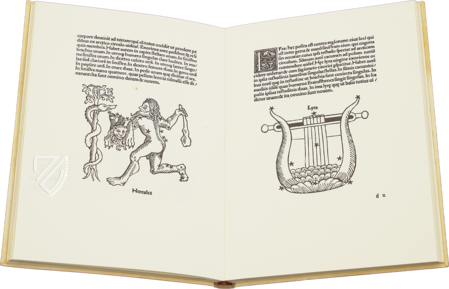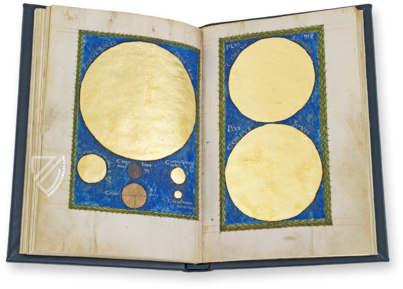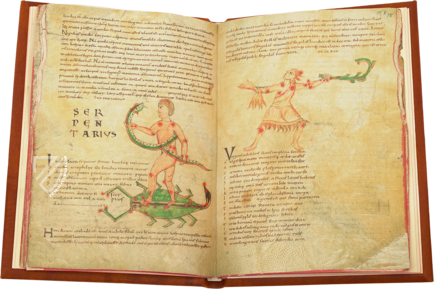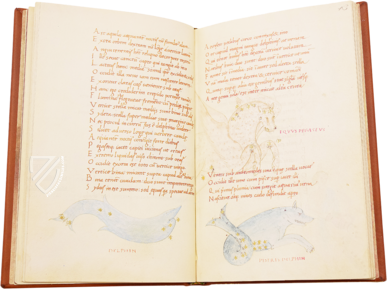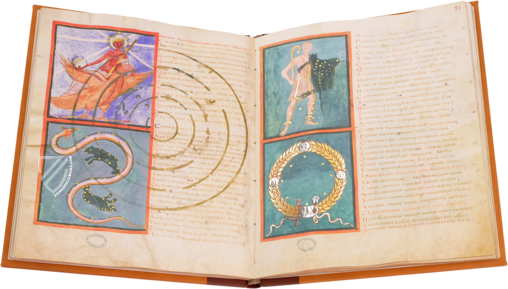Vatican Aratea
The Vatican Aratea is an opulently illuminated astronomical textbook based on the ancient model of the text Phainomena by the poet Aratos of Soloi (ca. 310–245 v. Chr.), which was the standard work of astronomy in Europe for centuries. Furnished with 40 large gold-decorated miniatures, it explains the planets, celestial phenomena, and weather signs. The reader is introduced to the complex astronomical knowledge by means of fascinating mythological stories and figures, which have been artfully translated into pictures by the gifted illuminator Matteo Felice. This magnificent astronomical manuscript was created in the second half of the 15th century for King Ferdinand I of Naples (1424–1494) or his son Giovanni (1456–1485) and is a wonderful artistic and literary testimony to the early Renaissance in Italy. Its Baroque velvet binding with precious embroidery was commissioned by Cardinal Maffeo Barberini (1568–1644), later Pope Urban VIII.
Courtly Astronomy from Naples
The Vatican Aratea is not only an artistic testimony of the Italian Renaissance, but also one of the most luxurious copies of the famous astronomical didactic poem by Aratos of Soloi (ca. 310–245 BC). Its splendor perfectly reflects its royal patron from the Neapolitan royal court: the precious manuscript was presumably illuminated for King Ferdinand I of Naples (1424–1494) or his son Giovanni (1456–1485) by Matteo Felice with 40 gold-decorated miniatures and numerous decorated initials.
Ancient myths in the starry sky
Aratos of Soloi combined complex astronomical mathematics with vivid mythological stories in his Phainomena, which he wrote around 370 BC. This probably explains the work's popularity in antiquity and throughout the Middle Ages: the text was rediscovered as early as the Carolingian Renaissance, and Italian humanism brought it to the height of its reception. The Greek didactic poem was also translated into Latin several times. The Aratea Vaticana contains the Latin prose version of Germanicus (15 BC – 19 AD), which is complemented in the magnificent miscellany by Pliny's (23/24–79 AD) Naturalis historia and Hyginus' (1st or 2nd century AD) De Astronomia.
Radiant colors and opulent gold decoration
The manuscript begins with the Aratea, which is introduced by a beautiful decorative page. The beginning of the text is framed by a broad gold-decorated border made of white vine ornament typical of the period, in which putti and animals frolic. On fol. 3r follows arguably the most famous miniature in the manuscript: The Planisphere. This stunning circular depiction of the firmament shows all the constellations in vivid colors. The remaining 39 miniatures show the constellations and celestial phenomena inspired by Greek and Roman mythology, mostly one by one and in splendid golden frames and against a celestial background, while the stars shine in red and gold. They visually introduce the respective sections of the text. The typesetting itself – masterfully written in humanistic minuscule – is also adorned and structured by 60 golden champie initials.
A velvet binding for the later Barberini pope
When this astronomical manuscript came into the hands of one of the greatest patrons of the arts in Baroque Rome, Maffeo Barberini (1568–1644), later Pope Urban VIII, in the 16th century, he arranged for it to be rebound. The manuscript received a richly embroidered red velvet binding bearing the Barberini coat of arms on the back cover. The front shows St. Thomas kneeling before a Madonna with child, who appears as the Woman of the Apocalypse, as she is standing on a crescent moon. The manuscript, enhanced with this beautiful binding, was incorporated by Pope Leo XIII in 1901, together with the entire Barberini collection, into the Biblioteca Apostolica Vaticana, where it is still kept today under the signature Barb. lat. 76.
Codicology
- Alternative Titles
- Die Aratea Vaticana
Aratea Vaticanus
Aratea Vaticana - Size / Format
- 200 pages / 23.2 × 15.1 cm
- Origin
- Italy
- Date
- Second half of the 15th century
- Epochs
- Style
- Genre
- Language
- Script
- Humanistic minuscule
- Illustrations
- 40 diagrams and miniatures; 1 elaborately framed incipit page; 60 gold champie initials
- Content
- Excerpts from Germanicus' Latin translation of the Phaenomena of Aratus, from the Natural History of Pliny the Elder and from Hyginus' De astronomia
- Patron
- Ferdinand I, King of Naples, or his son Giovanni
- Artist / School
- Matteo Felice (illuminator)
- Previous Owners
- Maffeo Barberini
Vatican Aratea
A royal patron
The opulent decorated frame of the first page provides information about the royal patronage of the manuscript: Four putti bear a gold-fringed laurel wreath embracing the arms of King Ferdinand I, known as Ferrante of Naples. A golden crown also hovers above the blazon with fleurs-de-lys and red stripes. Nevertheless, researchers argue about whether Ferdinand I really commissioned the magnificent manuscript or whether it was his third son John of Naples. However, the only certainty is that a member of the royal family under Ferdinand I had the astronomical gem made.
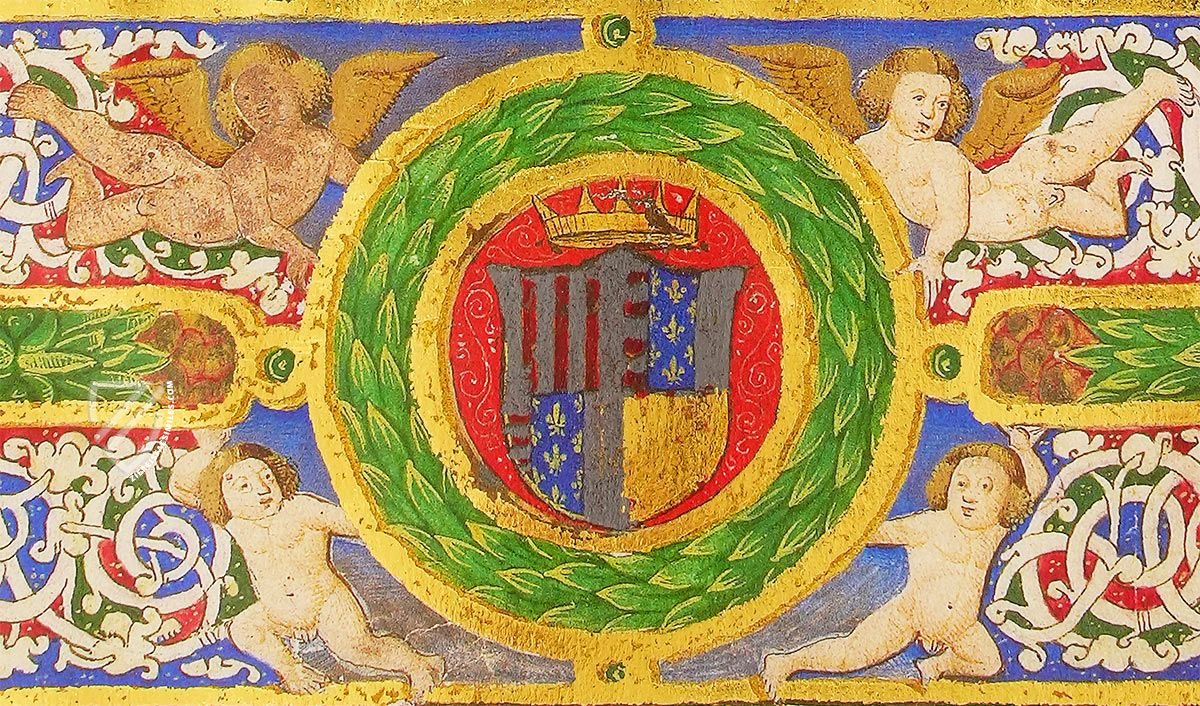
Vatican Aratea
Planisphere
Probably the best-known miniature of the astronomical text represents the magnificent picture page of a celestial map. In this celestial or star map, the position of the constellations in the night sky is reproduced without depicting the individual stars themselves. With the fascination for the celestial sphere, ancient constellations were taken up in medieval manuscripts and treated in various splendid manuscripts. Myths, rites, and cultic worship were attached to astronomy as a science, leading to a fusion of celestial science and mythology. The Aratea Vaticana is one of the most beautiful copies of the Italian Renaissance, based on the ancient Phainomena by the poet Aratos of Soloi.
In the planisphere, the firmament is depicted in five golden circles, in which all the constellations and celestial phenomena are embedded in brilliant colors. The 39 carefully executed depictions were inspired by Greek and Roman mythology and are influenced by Arabic iconography, making this manuscript a treasure of Italian Renaissance artwork.
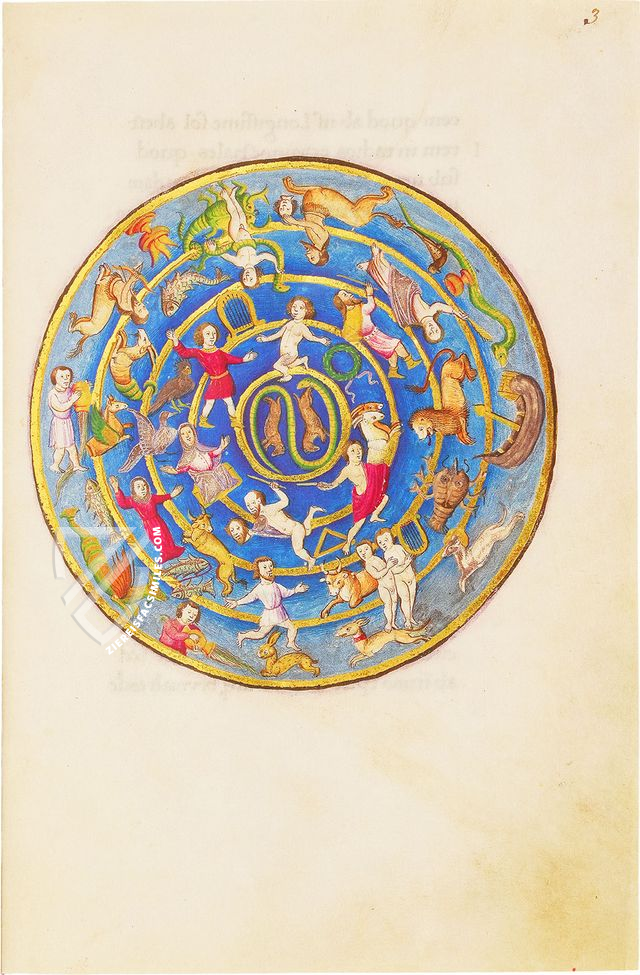
#1 Die Aratea Vaticana
Language: English, German
- Treatises / Secular Books
- Apocalypses / Beatus
- Astronomy / Astrology
- Bestiaries
- Bibles / Gospels
- Chronicles / History / Law
- Geography / Maps
- Saints' Lives
- Islam / Oriental
- Judaism / Hebrew
- Single Leaf Collections
- Leonardo da Vinci
- Literature / Poetry
- Liturgical Manuscripts
- Medicine / Botany / Alchemy
- Music
- Mythology / Prophecies
- Psalters
- Other Religious Books
- Games / Hunting
- Private Devotion Books
- Other Genres
- Afghanistan
- Armenia
- Austria
- Belgium
- Belize
- Bosnia and Herzegovina
- China
- Colombia
- Costa Rica
- Croatia
- Cyprus
- Czech Republic
- Denmark
- Egypt
- El Salvador
- Ethiopia
- France
- Germany
- Greece
- Guatemala
- Honduras
- Hungary
- India
- Iran
- Iraq
- Israel
- Italy
- Japan
- Jordan
- Kazakhstan
- Kyrgyzstan
- Lebanon
- Liechtenstein
- Luxembourg
- Mexico
- Morocco
- Netherlands
- Palestine
- Panama
- Peru
- Poland
- Portugal
- Romania
- Russia
- Serbia
- Spain
- Sri Lanka
- Sweden
- Switzerland
- Syria
- Tajikistan
- Turkey
- Turkmenistan
- Ukraine
- United Kingdom
- United States
- Uzbekistan
- Vatican City
- A. Oosthoek, van Holkema & Warendorf
- Aboca Museum
- Ajuntament de Valencia
- Akademie Verlag
- Akademische Druck- u. Verlagsanstalt (ADEVA)
- Aldo Ausilio Editore - Bottega d’Erasmo
- Alecto Historical Editions
- Alkuin Verlag
- Almqvist & Wiksell
- Amilcare Pizzi
- Andreas & Andreas Verlagsbuchhandlung
- Archa 90
- Archiv Verlag
- Archivi Edizioni
- Arnold Verlag
- ARS
- Ars Magna
- ArtCodex
- AyN Ediciones
- Azimuth Editions
- Badenia Verlag
- Bärenreiter-Verlag
- Belser Verlag
- Belser Verlag / WK Wertkontor
- Benziger Verlag
- Bernardinum Wydawnictwo
- BiblioGemma
- Biblioteca Apostolica Vaticana (Vaticanstadt, Vaticanstadt)
- Bibliotheca Palatina Faksimile Verlag
- Bibliotheca Rara
- Boydell & Brewer
- Bramante Edizioni
- Bredius Genootschap
- Brepols Publishers
- British Library
- C. Weckesser
- Caixa Catalunya
- Canesi
- CAPSA, Ars Scriptoria
- Caratzas Brothers, Publishers
- Carus Verlag
- Casamassima Libri
- Centrum Cartographie Verlag GmbH
- Chavane Verlag
- Christian Brandstätter Verlag
- Circulo Cientifico
- Club Bibliófilo Versol
- Club du Livre
- CM Editores
- Collegium Graphicum
- Collezione Apocrifa Da Vinci
- Comissão Nacional para as Comemorações dos Descobrimentos Portugueses
- Coron Verlag
- Corvina
- CTHS
- D. S. Brewer
- Damon
- De Agostini/UTET
- De Nederlandsche Boekhandel
- De Schutter
- Deuschle & Stemmle
- Deutscher Verlag für Kunstwissenschaft
- DIAMM
- Droz
- E. Schreiber Graphische Kunstanstalten
- Ediciones Boreal
- Ediciones Grial
- Ediclube
- Edições Inapa
- Edilan
- Editalia
- Edition Deuschle
- Edition Georg Popp
- Edition Leipzig
- Edition Libri Illustri
- Editiones Reales Sitios S. L.
- Éditions de l'Oiseau Lyre
- Editions Medicina Rara
- Editorial Casariego
- Editorial Mintzoa
- Editrice Antenore
- Editrice Velar
- Edizioni Edison
- Egeria, S.L.
- Eikon Editores
- Electa
- Emery Walker Limited
- Enciclopèdia Catalana
- Eos-Verlag
- Ephesus Publishing
- Ernst Battenberg
- Eugrammia Press
- Extraordinary Editions
- Fackelverlag
- Facsimila Art & Edition
- Facsimile Editions Ltd.
- Facsimilia Art & Edition Ebert KG
- Faksimile Verlag
- Feuermann Verlag
- Folger Shakespeare Library
- Franco Cosimo Panini Editore
- Friedrich Wittig Verlag
- Fundación Hullera Vasco-Leonesa
- G. Braziller
- Gabriele Mazzotta Editore
- Gebr. Mann Verlag
- Gesellschaft für graphische Industrie
- Getty Research Institute
- Giovanni Domenico de Rossi
- Giunti Editore
- Graffiti
- Grafica European Center of Fine Arts
- Guido Pressler
- Guillermo Blazquez
- Gustav Kiepenheuer
- H. N. Abrams
- Harrassowitz
- Harvard University Press
- Helikon
- Hendrickson Publishers
- Henning Oppermann
- Herder Verlag
- Hes & De Graaf Publishers
- Hoepli
- Holbein-Verlag
- Houghton Library
- Hugo Schmidt Verlag
- Idion Verlag
- Il Bulino, edizioni d'arte
- ILte
- Imago
- Insel Verlag
- Insel-Verlag Anton Kippenberger
- Instituto de Estudios Altoaragoneses
- Instituto Nacional de Antropología e Historia
- Introligatornia Budnik Jerzy
- Istituto dell'Enciclopedia Italiana - Treccani
- Istituto Ellenico di Studi Bizantini e Postbizantini
- Istituto Geografico De Agostini
- Istituto Poligrafico e Zecca dello Stato
- Italarte Art Establishments
- Jan Thorbecke Verlag
- Johnson Reprint Corporation
- Josef Stocker
- Josef Stocker-Schmid
- Jugoslavija
- Karl W. Hiersemann
- Kasper Straube
- Kaydeda Ediciones
- Kindler Verlag / Coron Verlag
- Kodansha International Ltd.
- Konrad Kölbl Verlag
- Kurt Wolff Verlag
- La Liberia dello Stato
- La Linea Editrice
- La Meta Editore
- Lambert Schneider
- Landeskreditbank Baden-Württemberg
- Leo S. Olschki
- Les Incunables
- Liber Artis
- Library of Congress
- Libreria Musicale Italiana
- Lichtdruck
- Lito Immagine Editore
- Lumen Artis
- Lund Humphries
- M. Moleiro Editor
- Maison des Sciences de l'homme et de la société de Poitiers
- Manuscriptum
- Martinus Nijhoff
- Maruzen-Yushodo Co. Ltd.
- MASA
- Massada Publishers
- McGraw-Hill
- Metropolitan Museum of Art
- Militos
- Millennium Liber
- Müller & Schindler
- Nahar - Stavit
- Nahar and Steimatzky
- National Library of Wales
- Neri Pozza
- Nova Charta
- Oceanum Verlag
- Odeon
- Orbis Mediaevalis
- Orbis Pictus
- Österreichische Staatsdruckerei
- Oxford University Press
- Pageant Books
- Parzellers Buchverlag
- Patrimonio Ediciones
- Pattloch Verlag
- PIAF
- Pieper Verlag
- Plon-Nourrit et cie
- Poligrafiche Bolis
- Presses Universitaires de Strasbourg
- Prestel Verlag
- Princeton University Press
- Prisma Verlag
- Priuli & Verlucca, editori
- Pro Sport Verlag
- Propyläen Verlag
- Pytheas Books
- Quaternio Verlag Luzern
- Reales Sitios
- Recht-Verlag
- Reichert Verlag
- Reichsdruckerei
- Reprint Verlag
- Riehn & Reusch
- Roberto Vattori Editore
- Rosenkilde and Bagger
- Roxburghe Club
- Salerno Editrice
- Saltellus Press
- Sandoz
- Sarajevo Svjetlost
- Schöck ArtPrint Kft.
- Schulsinger Brothers
- Scolar Press
- Scrinium
- Scripta Maneant
- Scriptorium
- Shazar
- Siloé, arte y bibliofilia
- SISMEL - Edizioni del Galluzzo
- Sociedad Mexicana de Antropología
- Société des Bibliophiles & Iconophiles de Belgique
- Soncin Publishing
- Sorli Ediciones
- Stainer and Bell
- Studer
- Styria Verlag
- Sumptibus Pragopress
- Szegedi Tudomànyegyetem
- Taberna Libraria
- Tarshish Books
- Taschen
- Tempus Libri
- Testimonio Compañía Editorial
- Thames and Hudson
- The Clear Vue Publishing Partnership Limited
- The Facsimile Codex
- The Folio Society
- The Marquess of Normanby
- The Richard III and Yorkist History Trust
- Tip.Le.Co
- TouchArt
- TREC Publishing House
- TRI Publishing Co.
- Trident Editore
- Tuliba Collection
- Typis Regiae Officinae Polygraphicae
- Union Verlag Berlin
- Universidad de Granada
- University of California Press
- University of Chicago Press
- Urs Graf
- Vallecchi
- Van Wijnen
- VCH, Acta Humaniora
- VDI Verlag
- VEB Deutscher Verlag für Musik
- Verlag Anton Pustet / Andreas Verlag
- Verlag Bibliophile Drucke Josef Stocker
- Verlag der Münchner Drucke
- Verlag für Regionalgeschichte
- Verlag Styria
- Vicent Garcia Editores
- W. Turnowski Ltd.
- W. Turnowsky
- Waanders Printers
- Wiener Mechitharisten-Congregation (Wien, Österreich)
- Wissenschaftliche Buchgesellschaft
- Wissenschaftliche Verlagsgesellschaft
- Wydawnictwo Dolnoslaskie
- Xuntanza Editorial
- Zakład Narodowy
- Zollikofer AG

